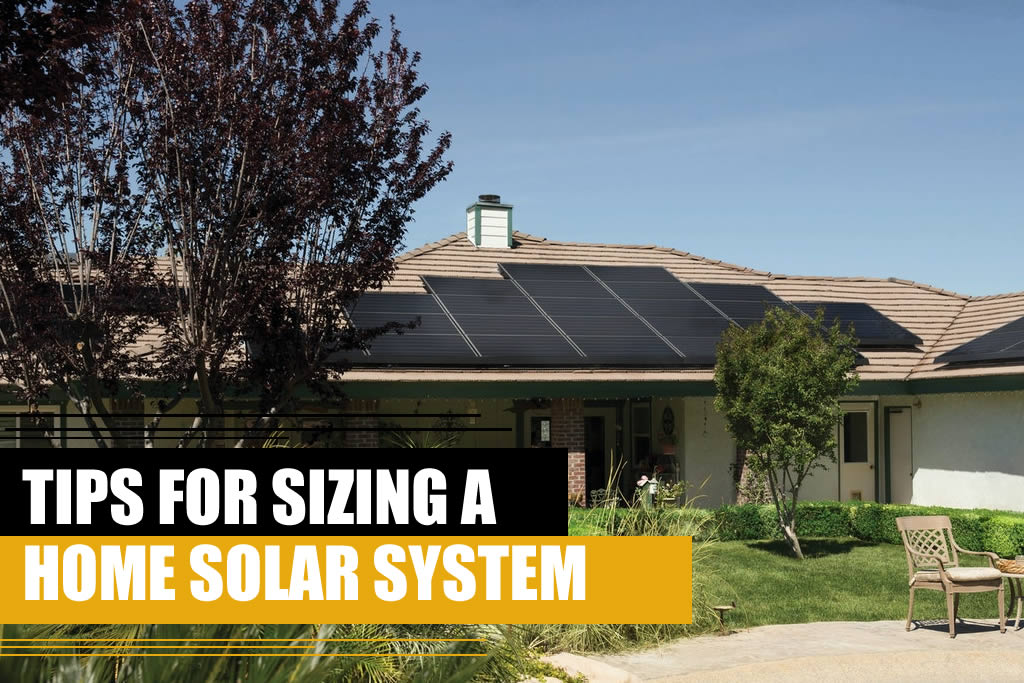
With increased awareness of global warming and a possibility for cutting energy costs, it is not difficult to see why more and more homeowners resort to installing a solar photovoltaic (PV) system on the roof of their homes.
The PV arrays are deemed as a smart investment because, in addition to the fact that it is suitable for both environment and your pocket, they are simple to install and easy to maintain and operate. If you have decided to move forward with your solar ambition, here are some tips for correctly sizing a home solar system!

1. Calculate your home’s kWh usage
The first step to sizing a home solar system is determining your home’s energy usage as accurately as possible or, in other words, calculating how much energy you use daily. There’s more than one way to do this.
Electricity bills
For starters, you can do this by collecting your home electricity bills for the past 12 months. By looking at your consumption data throughout a year, you will be able to see peaks and valleys in your regular usage, along with the spikes caused by heavy use of air-conditioning in summer and heating units in winter.
To determine your average monthly energy consumption, start by adding up the kWh usage for all 12 months. Then, divide this figure by 12 for monthly kWh usage. To calculate your daily kWh usage, divide the number by 30.
Energy monitor
If you wish to be even more accurate in your calculations, you can opt for installing a whole-house energy monitor, as it will provide a precise reading of your daily energy use. It calculates the watt-hours per week for each appliance in your home.
Listing devices
You can also do the same thing the old-fashioned way by listing out every appliance in your home that you intend to run off your solar system and write the output wattage of each appliance next to it. To find the output wattage, look for the power consumption rating label printed on each device or its charger, and look for the output rating.
If the wattage is explicitly listed on the label, write down the given number next to its appliance on your list. If, however, you’re left with volts and amps, use the following equation to convert those into your output wattage:
Watts (W) = Volts (V) x Amps (A)
And, in case you have milliamps as your variable, just take that number and divide it by 1000, so:
Milliamps (mA) / 1000 = Amps (A)
If you’re unable to find the power consumption rating label of a device, either find the model number of this device and conduct a Google search, or look online for a device similar to the one you have to get a general idea.
Once you’ve composed a list of your home appliances and their corresponding output wattage, write down the approximate number of hours you use each appliance daily. If you’re used to using a particular device only for 15 minutes a day, write 0.25 in the space or 0.5 for 30 minutes.
Multiply the output wattage and the number of hours to get the watts hours per day of each device. For example, if you have two phone charges, multiply the number you get by 2. Repeat this process for each appliance, then add all watt-hour figures to get the total number of watt-hours per day.
2. Determine the solar insolation
Solar insolation is a formula measuring the power of incoming sunlight over a specific surface area during a certain amount of time. I.e., it is the average number of peak sun hours per day (differs from “hours of daylight), and this number tells you the amount of sun exposure your panels are likely to receive that can be used for efficient energy production.
Your home’s location
Average peak sun hours depend on your home’s specific location and local climate because not all places receive the same amount of annual sunshine.
For example, if you live in Florida or California, you’re lucky because these states are likely to see more clear and sunny days than other states, which is especially important if you choose to install an off-grid solar system. Better yet, if you’re moving to another place in Texas, you can relax because relocating stress-free from the city you currently live in is guaranteed.
For example, San Antonio gets an average of 224 total days with sun a year, while El Paso gets 293. Also, a solar panel produces more energy when the sun is high in the sky and less in cloudy conditions or during winter when the sun is low in the sky

Therefore, you need to look up a solar insolation map online for the daily sun hours of your specific area. Find either your location or the city that is closest to you, and note down the daily average. The typical number of peak sun-hours in the US averages between 3 and 5. Alternatively, you can find an insolation meter available for purchase or even make your own.
3. Account for standard energy losses
The PV derating factor is the amount of electricity generated in real-world operating conditions after all standard electrical losses had been accounted for. It’s a pretty helpful tool if you want to know your solar system’s actual performance.
However, if you were to ask the professionals found at any of the solar companies in Texas, they would’ve explained that this factor is calculated based on your specific system, which requires you to understand its components.
Some people only use the thermal coefficient listed on the solar panel datasheet because it’s the system’s largest loss factor. But, to be more accurate, try to include other factors as well (inverter losses, horizon shading, soiling or snow on the panels, age of the panel, etc.).
The National Renewable Energy Laboratory, or NREL, uses the factor of 0.77 after calculating all of the above-mentioned default values for loss values.
4. Calculate the size of your solar system
Now that you have got two key figures, you can calculate the size of your PV array:
-
- Daily kWh / # peak sun hours = # kW – Take your daily kWh energy requirement (from step 1) and divide it by your number of peak sun-hours (from step 2) to determine the kW your solar system should be generating per day.
- # kW x 0.77= # kW – Then, increase the size of your system by 0.77, which presents PV systems’ standard energy losses, and what you get is the actual size of the solar system you need. Keep in mind that this is a default value, and yours may be different.
5. Consider the site for your panels
Once you’ve calculated the capacity of the system, think about where you can put the panels. Using a roof-mounted system would be the simplest, as well as a less pricy solution. To fine-tune the estimation of your solar system design, if you’re considering your roof, you’ll need to consider the right roof mount, your panels facing the right direction, and the right size of the panels that will fit your system’s design.
The same goes if you’re moving somewhere else. Before contacting State to State Move professionals to move you to a different site, take this into consideration because the site and the house will significantly affect the size of solar panels, quantity, as well as efficiency.
So, what also matters when sizing a home solar system is making sure your roof faces south, isn’t in partial shade, and the space on it can accommodate the number of panels you require for your home. If so, you can purchase larger panels at a lower cost per each to satisfy the target energy output. If not, it would be smarter to use fewer smaller panels that are high efficiency.
